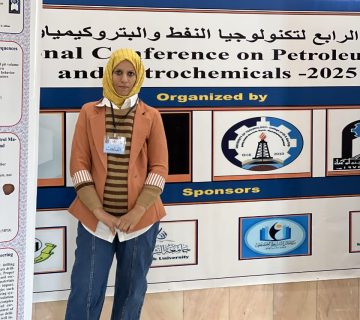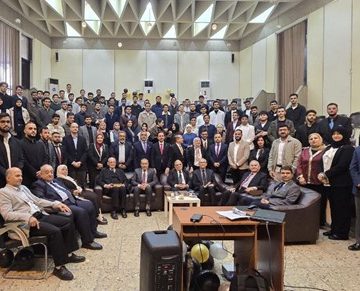Environmental Engineering Department at the College of Engineering, University of Baghdad, held PhD dissertation examination titled:
“Improving photocatalytic degradation of organic dyes and pathogenic bacteria using ZnXMn(1-X)Fe2O4@Ag-AgVO3 heterojunction”
By the student Nuralhuda Aladdin Jasim and supervised Prof.Dr. Shahla Ismail Ibrahim and Prof.Dr. Saad Hanash Ammar on Sunday 21/4/2024, in the Environmental Engineering discussion hall. The examination committee consisted of Prof.Dr. Ayad Abdlhamza Faisal as Chairman, and the membership of Prof.Dr. Khalid Khazaal Hummadi, Assist.Prof.Dr. Haider Mohammed Abdalhameed, Assist.Prof.Dr. Hussien Majeed Faleeh and Assist.Prof.Dr. Yusr Riadh Abdlamajeed. After conducting the public discussion and listening to the student’s defense, the dissertation was accepted. It was summarized as follows:
Different metal ferrites were synthesized with various molar ratio such as Zn0.5Mn0.5Fe2O4, Co0.5Mn0.5Fe2O4, Co0.5Zn0.5Fe2O4, as Zn0.3Mn0.7Fe2O4, Co0.3Mn0.7Fe2O4, Co0.3Zn0.7Fe2O4, Zn0.7Mn0.3Fe2O4, Co0.7Mn0.3Fe2O4, Co0.7Zn0.3Fe2O4, MnFe2O4, CoFe2O4, and ZnFe2O4. Additionally, nanorods of varied sizes were synthesized for AgVO3 and Ag/AgVO3 in both the supported “ZnXMn(1-X)Fe2O4/AgVO3”, “ZnXMn(1-X)Fe2O4/Ag-AgVO3”, and core/shell “ZnXMn(1-X)Fe2O4@ AgVO3” and “ZnXMn(1-X)Fe2O4/Ag-AgVO3” configurations, where (X from 0.1 to 1). The different nanocomposites were synthesized using facile multistep method including hydrothermal and coprecipitation approaches. The nanocomposites were listed in the following order: AgVO3, Ag@AgVO3, Zn0.3Mn0.7Fe2O4/AgVO3, Zn0.5Mn0.5Fe2O4/AgVO3, Zn0.7Mn0.3Fe2O4/AgVO3, Zn0.3Mn0.7Fe2O4/Ag-AgVO3,Zn0.5Mn0.5Fe2O4/Ag-AgVO3,Zn0.7Mn0.3Fe2O4/Ag-AgVO3,Zn0.3Mn0.7Fe2O4@AgVO3,Zn0.5Mn0.5Fe2O4@AgVO3,Zn0.7Mn0.3Fe2O4@AgVO3,Zn0.3Mn0.7Fe2O4@Ag-AgVO3,Zn0.5Mn0.5Fe2O4@Ag-AgVO3, Zn0.7Mn0.3Fe2O4@Ag-AgVO3 respectively. The investigation focused on examining the photocatalytic efficiency of supported and core/shell nanostructures in nanocomposites for the breakdown of organic dyes such as rhodamine B and Methyl orange, as well as elucidating the underlying mechanism of this reaction. Various scavengers were employed to identify the active species present in the system. Electrons play a pivotal role as the primary species in the process of breakdown in scavenger investigations. First of all, under specific conditions, the nanocomposite Zn0.7Mn0.3Fe2O4 MNPs demonstrates a greater reduction degradation, which can reach 99% after 180 minutes of exposure to visible light. These conditions include an acidic pH, a low catalyst concentration, and 240 mM of hydrogen peroxide. Pseudo-first-order kinetics proved to be an excellent fit to the experimental data. Secondly, Co0.3Zn0.7Fe2O4 nanoparticles demonstrated an exceptional rate of Rh B dye degradation in acidic conditions during optimal testing circumstances. Under the same test conditions, the Co0.3Zn0.7Fe2O4 photocatalyst decolored Rh B to 99% of its original hue. TOC elimination was observed; to 95% after three hours (180 minutes). When measured against the following standards, the performance was excellent at the following criteria: the hydrogen peroxide concentration was 240 mM, the dye concentration was 10 mg/L, the catalyst concentration was 0.5 mg/L, and the pH value was set to 3.0.
Thirdly, nanorods of varied sizes were observed for AgVO3 in the core/shell Zn0.3Mn0.7Fe2O4@AgVO3 configurations. Various scavengers were employed to identify the active species present in the system. Electrons play a pivotal role as the primary species in the process of breakdown in scavenger investigations. Fourthly, the supported Zn0.3Mn0.7Fe2O4/AgVO3 configurations had AgVO3 nanorods of varying diameters. The supported nanocomposites were synthesized using coprecipitation method. The photocatalytic efficiency of heterogenous composite is investigated in which expressed as 99.99% degradation efficiency. Scavenger research relies on electrons for breakdown and it was expressed that the potassium dichroite was the most efficient species. Acidic pH, low concentration of Rh B dye, low dose of catalyst, 120 mM of hydrogen peroxide were used as the optimum conditions for enhancing the degradation performance of Rh B organic dye. Fifthly, the fabrication of highly active Zn0.5Mn0.5Fe2O4 /Ag-AgVO3 nanocomposite photocatalysts was made possible by a straightforward coprecipitation approach.
Moreover, the experiment with radical trapping provided evidence that • OH and h+, significantly contribute to the breakdown of Rh B. Degradation efficiency for Zn0.5Mn0.5Fe2O4 /Ag-AgVO3 composite is particularly high at 99.99 % in just 180 min. Reduction in COD was shown after 240 min leading to 90% of reduction. In the photocatalytic process, the primary active species responsible for interacting with pollutants were the active holes (h+). Sixthly, for Zn0.5Mn0.5Fe2O4@Ag-AgVO3, this work effectively fabricated magnetic heterogeneous photocatalyst materials composed of ternary ZnxMn1-xFe2O4@Ag-AgVO3 system using precipitation and hydrothermal processes. Charge transfer pathways between the Zn0.5Mn0.5Fe2O4, AgVO3, and plasmonic Ag in this heterostructure lead to the boosted photodegradation result. The maximum photocatalytic removal effectiveness of 99% was achieved by the Zn0.5Mn0.5Fe2O4@Ag-AgVO3after 180 min of visible light irradiation under certain conditions, such as an acidic pH, photocatalyst concentration, and 120 mM of H2O2.
Additional explanation of organic pollutant (Methyl orange) was performed using supported and core/shell nanocomposites, the results demonstrated that the core/shell and supported nanocomposites expressed high-rate removal efficiency in which approximately (96.99% for core/shell composites) and (85% for supported nanocomposites). The optimum conditions were 0.1 g/L dose of catalysts, 10 g/L of concentration of pollutants, and pH=2.0 for supported and pH=7-7.5 for core/shell composites.
The use of supported and core/shell nanocomposites allowed for further elucidation of bacterial inactivation. The Pseudomonas aeruginosa was utilized in order to investigate the photo killing and reduction in cell density. The elimination of bacteria was occurred after 5 min of exposure under visible light irradiation (VLI). Furthermore, after 30 minutes of the reaction occurring with the catalyst, practically all bacteria had been killed for both types of nanocomposites. When tested with P. aeruginosa, both nanocomposites achieved an inactivated bacterial ratio of 99.99% relative to total bacteria. The 0.25 g/L was found to be the ideal concentration for the removal of p. aeruginosa. The photocatalyst loading on the P. aeruginosa was found to be 3.12*106 cfu/mL which is the ideal population for P. aeruginosa. pH value of 7 is the optimum value for photocatalytic reaction based on cost consideration. The susceptibility test of different nanocomposites synthesized chemically is supported by the no inhibition rates reported by chemical synthesis.
Seventhly, based on the “3-(4, 5-dimethylthiazolyl-2)-2, 5-diphenyltetrazolium bromide” MTT obtained results, the core/shell nanocomposites displayed a dose-dependent pattern of cytotoxicity against “MCF-7” cell lines when contrasted with the normal WRL-68 cell line. The effectiveness of core/shell composites more than supported nanocomposites in killing tumor cells was found to be more potent against MCF-7 (IC50 110.5%) for core/shell than for supported (IC50 130.4%).
In numerous biological processes, including cell differentiation, homeostasis, and development, apoptosis is a crucial player. Disruptions in the control of cell death are common in cancer cases. Based on the analysis regarding cytotoxicity and “High content screening” HCS, it was indicated that using core/shell composites as a promising agent in cancer therapy.
The recommendations of this dissertation:
- Study the possibility of replacing the “ZnxMn(1-X)Fe2O4”, and CoxZn(1-X)Fe2O4 with CoXNi(1-X)Fe2O4, CoXMn(1-X)Fe2O4, ZnxNi(1-X)Fe2O4 and NixMn(1-X)Fe2O4. Moreover, choosing another spinal ferrite such as NiFe2O4 and CoFe2O4 instead of ZnFe2O4 and MnFe2O4.
- Study other nanocomposites for both supported and core/shell (silver doping metal ferrites) such as AgNWs@ZnFe2O4, [email protected], AgFeO2, AgFeO2-G, AgFe2O4/PANI, ZnFe2O4/AgI (silver Iodide), Ag-MgFe2O4, Ag-doped CuFe2O4, MnFe2O4/Ag, NiFe2O4@Ag semiconductor due to its magnetic and optical properties.
- Other photoactive metal ferrites are considered to be used, such as nickel metal ferrites and cobalt metal ferrites instead of zinc-manganese metal ferrites such as NiFe2O4, CoFe2O4, “CoXNi(1-X)Fe2O4”, “CoXMn(1-X)Fe2O4” instead of “ZnXMn(1-X)Fe2O4”.
- Study the possibility of developing Z-scheme heterojunction using various silver-based semiconductors such as AgFeO2, Agl, Ag3VO4, Ag2CO3, Ag2S, Ag2O, AgBr, Ag2CO3, Ag2ZrO3, Ag3PO4, etc.
- Investigating the effect of other operating parameters such as dissolved oxygen, reaction temperature, light intensity, wavelength, inorganic salt, etc.
- Investigating the photocatalytic degradation activity against other organic pollutants such as Methyl Blue (MB), malachite green (MG), “crystal violet” (CV), “methylene blue” (MB), Reactive Black 5 (RB5), Congo red (CR), orange 7 (AO7), phenol, aldehyde, tetracycline, and pesticides, etc.
- Study the possibility of inactivate other pathogenic microbes such as S. aureus, E. coli, B. subtilis, clostridium perfringens, etc.
- Investigating core/shell nanocomposites’ harmful effects through molecular analysis of apoptosis-related gene expression, including Bcl- 2, p53, Bax and Bid.
- Attempting to improve the toxicity and efficacy of other core/shell nanocomposites as tumor proliferative agent. In addition, surveying more nanoparticles as promising anti-cancer from other types of synthesized nanocomposites have been synthesized in this research such as ZnXMn(1-X)Fe2O4@AgVO3 and ZnXMn(1-X)Fe2O4/AgVO3. In other words, studying other nanocomposites and testing HCS and cytotoxicity for investigating whether can be used as a promising agent in cancer therapy and trying another cancer line cells for other parts of human body because in our analysis the breast cancer cell MCF-7 only used as an example for this investigation.
- More investigations are needed for detection the apoptosis and cellular uptake, estimation of caspase activity, and investigating the effect of core/shell nanocomposite on arresting cell cycle by flow cytometric analysis.







